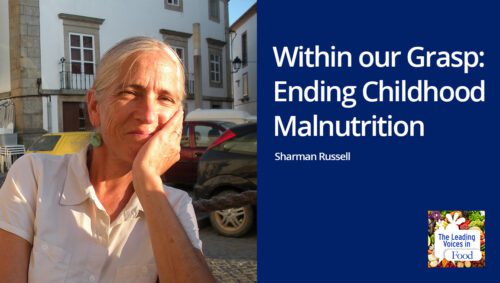The Leading Voices in Food
E23: Al Sommer on Vitamin A, Blindness and Global Politics
We speak today with someone whose work is credited with preventing 400,000 cases of blindness and saving as many as 1 million deaths per year. Dr. Alfred Sommer has earned this place in global history. He discovered that Vitamin A deficiency reduces immune responsiveness and resistance to infectious diseases such as diarrhea and measles. He proved that vaccination for smallpox as late as six days after infection can prevent the disease. He demonstrated the effectiveness of a simple and effective tool for monitoring the nutritional health of children at high risk of dying from malnutrition, and he identified an early accurate predictor of optic nerve damage, signaling when to start Glaucoma therapy.
Subscribe: Apple Podcasts | TuneIN | Google Podcasts | SoundCloud | PocketCasts | Radio Public
Tags: Child Development & Nutrition | Diet & Nutrition | International Food & Ag Policy |

Al Sommer is a professor of epidemiology, ophthalmology and international health at Johns Hopkins University, and is dean emeritus of the Johns Hopkins Bloomberg School of Public Health. He is a member of both the National Academy of Sciences and the National Academy of Medicine. His research focuses on child survival and blindness prevention strategies on micronutrient interventions and on the interface between public health and clinical medicine. For his contributions to global health, he has received many awards including the Albert Lasker Award for Clinical Medicine, the Danone International Prize for Nutrition, among others.
Interview Summary
You’ve done groundbreaking work on Vitamin A that has saved many millions of lives in developing countries. Could you relive some of the steps you took in this discovery process? And, can you explain the problems caused by Vitamin A deficiency?
What we knew for years was that if you made animals or children (we had observational data from back in the late 1800s-early 1900s) Vitamin A deficient, then they develop a sequence of issues. And we were forever focused on the eye. The earliest manifestation is a child can’t see after sunset. They suffer from what’s called night blindness. More severe deficiency causes keratinization–a cornification of the outside of the conjunctiva of the eye (the white part of the eye) and then ultimately of the cornea (the clear part where you actually see through). With severe deficiency then that cornea can ulcerate and melt and entirely disappear, and you lose the eye within the course of a few minutes. What we now know, and we didn’t know when I first got into this game, was that in fact, the eye signs are not the earliest manifestations. The earliest manifestations, in fact, are so prosaic, that people hadn’t identified them with Vitamin A deficiency. The earliest manifestations are a diminution in the immune responsiveness, which means that children at risk–when they are infected with diarrhea or pneumonia or measles–have much less ability to fight off the infection, and therefore they have a much more severe clinical response, and a much higher mortality rate.
When you started the work on this issue, what was the extent of the problem and where in the world was it as its most severe?
The earliest studies–probably because that’s where the clinicians were attuned–were actually from Europe and Japan by what would be at the turn of the 1900s. By the time I got involved, because an agency in New York that was starting a blindness prevention program thought it might be an important issue, was in the early 1970s. And that was primarily on the basis of a very informal survey that was undertaken at WHO’s bequest back in the ’50s by three giants in nutrition and ophthalmology. Don MacLaren, Oman, and Esposito basically broke up the world, they each visited about five countries, talked to pediatricians and ophthalmologists and asked about seeing these eye conditions because that’s what people are focused on and that they tend to see it in the hospital. And often they were told yes we do in the diarrheal ward or the malnutrition ward see children who have either problems with night blindness or more critically have actually gone blind because of melting of their cornea. So there was a feeling that in the developing world, broadly, there were manifestations of deficiency. But nobody really knew how great the extent was, where it was most severe, who were the children who got it, and why did some children get it and other children did not get it, and what could be done about it. And that’s when I entered the picture and was asked for some assistance. Being someone who always asks questions before they dive in, I said, well, do we have any sense of how severe it is and where one might find it?
And at the time I was a resident in ophthalmology so I couldn’t go very far away from Baltimore. So we picked first one country, El Salvador, then Haiti, where we actually conducted a randomized survey in the rural areas looking for the disease. We looked at where we would find it, how severe it was to develop manifestations that became WHO criteria, how frequently or how prevalent were these various manifestations to qualify a Vitamin A deficiency as a “public health problem.” And we looked at the registries and the hospitals to see what they had recorded. And those showed that in fact, it was much more extensive in those two countries than anybody had previously thought. And that led me to write a manual for WHO on what are the ocular manifestations of Vitamin A deficiency, how to diagnose them, what are the criteria for a public health problem, and methodologically, how to go about carrying out a simple, representative survey in the population.
So that would have been the early 1970s. That led me again to say, well, it looks pretty prevalent in these two places we’ve looked. Now we need to know more about why some children get another it and other children don’t get it. And, why some are more severe than others and what can we do about it? This led me to put in a proposal that got funded and that I moved to Indonesia for three years where there was reasonable hospital-based evidence that there was a severe problem. And I then depicted it all the questions I would like to have answered before one can go about mounting some sort of an intervention program.
So the first step was to document the extent of the problem. What was the next step?
So when we went to Indonesia, we carried out three critical studies. One of them was essentially to examine everybody who came to the hospital with the eye size because that’s what we were focused on historically. That’s what Vitamin A deficiency was all about. Primarily because that was unique to Vitamin A deficiency. So I studied everybody that came in. We also carried out studies where we followed 6,000 children in six villages, examining them every three months for 18 months. That study was conducted with the thesis: why do some children get severe Vitamin A deficiency and some children living in the same village don’t. And then the third major study was a countrywide survey to document for Indonesia where the disease was most prevalent, and how severe might it be.
Now some of those studies yielded data that we hadn’t anticipated. So the one in which I examined all the children coming into the hospital–a lot of them came in for night blindness. That was simple. Our recommendation, which had been established by the World Health Organization on a committee that I sat on only a couple of years previously, was that could be treated with oral large dose Vitamin A. But a child who had more severe disease or early ulcers or keratinization of the cornea, they needed an emergency intra-muscular, water miscible Vitamin A injections. Now the problem with that nobody made water miscible Vitamin A. Vitamin A is an oil-soluble Vitamin, and around the world, you could find injectable Vitamin A, but it was all in oil. And one of the things we had discovered in reviewing the literature for this WHO technical committee, a couple of years previously, is that in rat experiments, if you inject a dose of oil miscible Vitamin A subcutaneously or intramuscularly in a rat or in a child, you don’t impact the Vitamin A status at all. It just sits there like a lump.
So sitting in a WHO room, we came up with the recommendation, based upon animal experiments, that really if you want it to be absorbed rapidly, that intramuscular injection has to be a water-miscible preparation. That would be like homogenized milk. That is that the fat is dispersed within the quart of milk; it doesn’t come up to the top as cream. I get to Indonesia, the first child presents with actually a corneal ulcer. So that’s a real emergency. I turned to my Indonesian colleagues, and I say get me some water miscible Vitamin A for injection. They looked at me like I was crazy, which I was because they had none. In fact, nobody had any, despite the WHO recommendation. Nobody had told the pharmaceutical industry to prepare injectable water miscible Vitamin A. So I was stuck initially without a recommended treatment.
I knew that if I injected the oil miscible Vitamin A intra-muscularly, it wasn’t going to have any impact. But I did remember some animal experiments in which when they gave the oily Vitamin eight to rats by mouth, it actually worked pretty quickly. So I got the injectable water miscible Vitamin A, sucked it up into a syringe, took off the needle and then squirted into the children’s mouth. Right after doing that first child, I then telexed colleagues at Roche and asked them if they would produce some water miscible injectable Vitamin A. And of course, they were happy to do it. But, they said it’s going to be three or four months by the time they formulate it, do toxicity testing, get permission from the Indonesian government and licensed to import it. So I was treating every child that came in for the next three or four months with this oil miscible old injectable stuff but putting it into their mouth instead of injecting it.
And they seem to respond very rapidly. When I eventually got the ward a miscible injectable version, I decided, you know, giving this old stuff orally seems to work very well. Let’s set up a randomized trial in which half the children who presented with corneal ulcers were given the old fashioned oil-miscible Vitamin A by mouth, and the other half were randomized to get the new water-miscible Vitamin A by injection. And the end of two months, we had done about 60 or 70 children, and their biochemical response and the clinical response was absolutely identical. Now, why this was critical? It took 5 to 10 years to convince my colleagues. Nobody else ever replicated this trial or attempted to replicate the trial. But nobody wanted to take away the injectable water-miscible Vitamin A, even though it was very hard to get. It took five to 10 years.
Originally, I argued enough that we could get as an asterisk “if you don’t have water-miscible Vitamin A for injection, give oil Vitamin A by mouth.” Took five to 10 years before we could get them to move that up as the primary recommendation because it’s so much safer. Anybody can do it. You don’t need a healthcare worker to inject it. And that, therefore, paved the way for what became these large scale programs for distributing high-dose Vitamin A supplementation, because you did not have to do it by injection. You could do it by mouth by simply giving a small capsule or an equal amount on a spoon.
So let’s talk about the large scale expansion of the work you did. Because one challenge, of course, in making the initial public health discoveries of scaling things up so that they can work for hundreds, thousands or millions of people. So how did you address this issue?
So yeah, I was again very fortunate. The head of UNICEF, while I was doing this work, was Jim Grant, probably the most effective UNICEF director general there was. The person who is his chief medical advisor was following my work on Vitamin A and would periodically ask me to come into the office in New York and brief Jim on what we were doing, and what we were finding. So I had a colleague who is in charge of the largest agency that had to do with the health of children who is interested in seeing whether or not this, in fact, was necessary, and whether or not it was effective. I also knew Nakajima at WHO, and he too got interested in whether or not this would be effective. I have to say that put me well-placed, to try and make the argument. I’m not sure it would have flown if it remained totally focused on blindness because there weren’t a lot of global health champions who are interested in spending money and resources on preventing blindness.
But it was soon after that I made this unexpected insight from that original study, where we were following new 6,000 children. Children who had early mild Vitamin A deficiency (just night blindness, the earliest ophthalmic clinical manifestation) were dying at much higher rates than the children who had no eye signs at all and had slightly better Vitamin A status. So that led us to do several randomized trials that demonstrated, convincingly, that distributing Vitamin A large dose capsules reduced the childhood mortality by about a third. Now again, nobody believed that either early on. So we had to replicate it. We got other people to replicate it. By 1992, and I think it was critical–there were still people arguing on both sides. Nobody actually had negative data, they just couldn’t believe that 2 cents worth of Vitamin A could reduce child mortality by a third.
So in 1992, these commentaries are still going back and forth. People are still debating. And I said this is ridiculous already. We already had six or seven randomized trials, and these are trials with 20,000 children. These are expensive, difficult to do trials and in four different countries. And so I called a meeting at the Rockefeller Retreat in Bellagio. In those days you could only have about 20-22 people. These were people who have been involved in these trials, people who were experts in child survival. And to make a long story short, we said we’re just going to answer two questions: is Vitamin A deficiency bad for children, and if we improve their Vitamin A status with these large dose supplements, which have essentially no side effects whatsoever, will we reduce childhood mortality? And after going through all the data over the entire week, on Friday morning, everyone agreed that yes it would.
And I said, okay. And I went to a side room, I wrote up a paragraph that said these are our conclusions from reviewing the data in detail collectively. Got everyone to sign it in blood and then asked everybody at the meeting when they went back home, because this was an international meeting, if they would publish their perspective of the results of this meeting in the favorite medical journals. So I published one in the Lancet, somebody published one in the British Journal of Ophthalmology, somebody published one in the Medical Journal of South Africa. And so within a few months, people who were respected in the child survival and nutrition pediatric area sort of swamped the medical literature with agreeing that in fact, this was an important potential program that could be effective. One of my concerns had always been would the right children get the supplement or only the healthier children get it, but it turned out in these trials that of course, they got it pretty right pretty well across the board.
That led Jim Grant and Nakajima to host a major meeting to inaugurate the supplementation. UNICEF and I would go to Congress every year, a particularly a very supportive at that time House Committee on Hunger, and report what the research has shown. And we would talk about the implications for child survival if we could, in fact, get out this distribution. So, Congress would allocate funds each year for these programs. And very importantly, the Canadians took a very, and still retain, a leadership role in making these Vitamin A supplements available to countries. And these are now given out in over 50 countries around the world, probably reaching maybe about 60 or 70% of the children who need it. But again, what made it move forward was first being able to demonstrate that this impact on child survival.
And this was back in the 80s and 90s when child survival was something that was on the top of the international health agenda. And everyone had these various programs from growth monitoring onward to improve child survival and reduce child mortality. So it hit at the right time on an issue that everybody was concerned about. I was fortunate to have engaged two critically influential people, the director generals of UNICEF and WHO, who followed the work through the research phase and saw the results come out positive repeatedly, and then bringing everything together and getting a general consensus as this was an important thing to do. So it’s, in some ways, it was a very fortuitous series of events that came together, made this program move forward on a global scale.
Once you made the discovery that supplementation could have such profound effects, I’m imagining that whether these programs got implemented within countries had a lot to do with political issues. And things like that that go beyond science. Is that true? And how did you navigate those things?
Yeah. Now that’s of course true. One of the advantages and one of the hang-ups at the same time was every country wanted to have its own randomized trial. And people did raise the issue of, is it ethical to do any more of these randomized trials after you’ve done of one, two or three and every one of them gives you a 35% reduction in mortality. How can you randomize children to a placebo? And the argument I could make early on, well, if we don’t do this trial, the country is not going to launch a program, a nationwide program. And when we do the trial, at least half the children again get Vitamin A, the other half who survive are going to get Vitamin A at the end of the trial, since we’re it ethically compelled to do that. And hopefully, it’ll cause the country to change policy.
By the time we had seven or eight trials, I couldn’t even live with that argument anymore. And that’s why we had the Bellagio meeting. And I just said, we have to do this. And then, of course, I would go and visit with the Minister of Health in dozens of countries, one by one, sometimes regional meetings to present the data and talk about the impact having their particular country, given their infant mortality rates, and child survival rates. And it wasn’t too slow of a process once we had gotten through that Bellagio brief and WHO and UNICEF jumped on. One of the critical things I remember was making a visit to East Africa for an entirely different reason to set up some other studies, and I had a stop in Nairobi. And the person who picked me up at the airport happened to be the regional advisor for nutrition.
And as he’s driving me into Nairobi, he tells me that they just got a directive from Jim Grant that every one of the country offices for UNICEF needed to build Vitamin A supplementation into the budget for the coming year. So part of the political process that helped was visiting with Ministries of Health, talking to the Ministers and showing them the data in a relatively straight-forward, simplified fashion, because they’ve got a million other things to do it and not necessarily epidemiologists. But the other one was having UNICEF behind us where Jim Grant tells a regional office to direct the countries to put it Vitamin A into their programming for the coming year. So again, it was a constellation of things that came together. Some of it science and a lot of it was personal.








